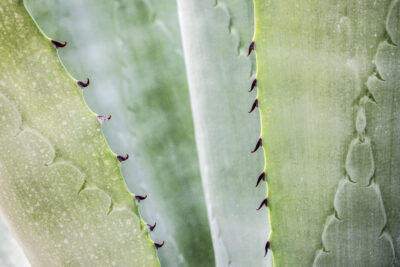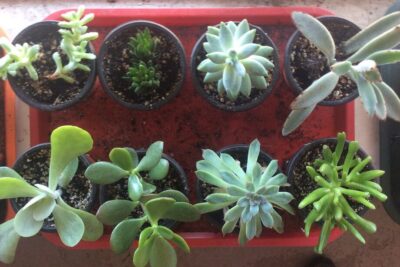
The Proper Depth for Planting Succulents in the Ground: A Guide

Succulents have become increasingly popular in recent years, both as indoor plants and as outdoor landscaping options. Known for their unique shapes and vibrant colors, succulents are low-maintenance plants that can thrive in a variety of environments. While many people are familiar with planting succulents in pots or containers, there is also the option of planting them directly in the ground. However, determining the proper depth for planting succulents in the ground can be a bit tricky.
We will delve into the topic of planting succulents in the ground and explore the optimal depth for their roots. We will discuss the importance of proper drainage and soil composition, as well as the factors to consider when choosing a planting location. Additionally, we will provide step-by-step instructions on how to plant succulents in the ground and offer tips for successful growth and maintenance. Whether you are a beginner gardener or a seasoned plant enthusiast, this guide will equip you with the knowledge and tools needed to create a thriving succulent garden.
- The proper depth for planting succulents in the ground depends on the size and type of succulent
- Generally, succulents should be planted at a depth that allows the roots to anchor securely in the soil
- For small succulents, a planting depth of 1-2 inches is usually sufficient
- Larger succulents may require a deeper planting depth of 3-4 inches
- It's important to avoid planting succulents too deep, as this can lead to root rot
- Succulents should be planted in well-draining soil to prevent waterlogged roots
- Adding a layer of gravel or rocks at the bottom of the planting hole can help improve drainage
- Once planted, succulents should be watered thoroughly but allowed to dry out between waterings
- Regular monitoring of the soil moisture level is important to ensure the succulents are not overwatered
- Proper depth for planting succulents is crucial for their overall health and longevity
- Frequently Asked Questions
The proper depth for planting succulents in the ground depends on the size and type of succulent
When it comes to planting succulents in the ground, it's important to consider the proper depth for optimal growth and health. The depth at which you plant your succulents will depend on their size and type. Here is a guide to help you determine the proper depth for planting different types of succulents:
Small Succulents:
For small succulents, such as Echeveria or Sedum varieties, a planting depth of about 1-2 inches is sufficient. This allows the roots to establish themselves in the soil while still keeping the plant stable.
Medium Succulents:
Medium-sized succulents, like Aloe or Agave plants, require a slightly deeper planting depth. Aim for a depth of 3-4 inches to provide ample space for the roots to spread and anchor the plant in the ground.
Large Succulents:
When it comes to large succulents, such as Cacti or Yucca plants, a deeper planting depth is necessary. Aim for a depth of 5-6 inches to ensure that the roots have enough room to establish a strong foundation and support the weight of the plant.
 How frequently should I apply Miracle-Gro Succulent Plant Food?
How frequently should I apply Miracle-Gro Succulent Plant Food?It's important to note that the depth should be measured from the base of the succulent, where the stems meet the roots. Avoid planting too shallow, as this can lead to instability and poor growth. Additionally, planting too deep can cause the stems to rot due to excess moisture.
Remember to loosen the soil before planting to ensure good drainage, as succulents are highly susceptible to root rot if they sit in waterlogged soil. Adding a layer of gravel or sand at the bottom of the planting hole can also help improve drainage.
Pro tip: If you're unsure about the proper depth for a specific succulent, it's always better to err on the side of caution and plant it slightly shallower. You can gradually increase the depth as the plant establishes itself and shows signs of healthy growth.
By following these guidelines for the proper depth when planting succulents in the ground, you can help ensure their long-term success and enhance the beauty of your garden.
Generally, succulents should be planted at a depth that allows the roots to anchor securely in the soil
When it comes to planting succulents in the ground, it's important to understand the proper depth at which they should be planted. Succulents, known for their ability to store water in their leaves and stems, have unique requirements when it comes to planting depth.
Planting succulents at the right depth ensures that their roots can anchor securely in the soil and allows for optimal growth and development. If the succulents are planted too shallow, they may not establish a strong root system, making them more susceptible to toppling over or being damaged by strong winds. On the other hand, planting them too deep can lead to root rot and hinder their ability to access sunlight, which is crucial for their survival.
 Watering Succulents After Repotting: What You Need to Know
Watering Succulents After Repotting: What You Need to KnowFactors to Consider
Several factors come into play when determining the proper depth for planting succulents in the ground:
- Type of Succulent: Different types of succulents have varying root structures. Some have shallow roots, while others have deeper or spreading roots. It's essential to research the specific succulent species you are planting to understand its root depth requirements.
- Soil Drainage: Succulents thrive in well-draining soil that allows excess water to flow away. If the soil retains too much moisture, it can lead to root rot. The planting depth should be adjusted accordingly to ensure proper drainage.
- Climate and Weather Conditions: The climate and weather conditions in your region also play a role in determining the planting depth. In areas with heavy rainfall or frequent watering, planting succulents slightly higher can help prevent waterlogged soil.
- Mature Size: Consider the mature size of the succulent when determining the planting depth. Some succulents may grow larger over time, and planting them too shallow may limit their growth potential.
General Guidelines
While the specific planting depth may vary depending on the factors mentioned above, there are some general guidelines to follow:
- Prepare the soil: Ensure the soil is well-draining by adding organic matter or sand if necessary.
- Dig a hole: Dig a hole that is slightly wider and deeper than the root ball of the succulent.
- Place the succulent: Gently place the succulent in the hole, making sure the top of the root ball is level with or slightly above the soil surface.
- Backfill: Fill the hole with soil, gently pressing it around the roots to eliminate air pockets.
- Water: Give the newly planted succulent a thorough watering to settle the soil and promote root establishment.
Remember, it's always advisable to consult specific planting guidelines for the particular succulent species you are working with, as they may have specific requirements that differ from general guidelines.
By planting your succulents at the proper depth, you can ensure their healthy growth and longevity in your garden.
For small succulents, a planting depth of 1-2 inches is usually sufficient
When it comes to planting small succulents in the ground, it is important to consider the proper depth to ensure their health and growth. In general, a planting depth of 1-2 inches is usually sufficient for small succulents.
Succulents have shallow root systems, so planting them too deep can lead to issues such as root rot and poor drainage. By planting them at the proper depth, you can provide them with the right conditions to thrive.
 Succulent Care: A Guide to Cliff Cotyledon and Crassulaceae
Succulent Care: A Guide to Cliff Cotyledon and CrassulaceaeHere are a few reasons why a planting depth of 1-2 inches is recommended:
- Avoiding excessive moisture: Succulents are adapted to arid environments and are prone to root rot if their roots sit in water for extended periods. Planting them at a shallow depth allows excess moisture to drain away more effectively, preventing the roots from becoming waterlogged.
- Promoting stability: Shallow planting helps establish a stable base for the succulents. Their roots can spread out horizontally, anchoring the plant securely in the ground. This stability is essential, especially in areas with strong winds or heavy rainfall.
- Encouraging efficient nutrient absorption: Succulents absorb nutrients primarily through their roots. Planting them at a shallower depth ensures that their roots can access the necessary nutrients present in the topsoil more efficiently. This promotes healthy growth and vibrant foliage.
However, it is important to note that the specific planting depth may vary depending on the succulent species and its size. Some larger succulents may require a slightly deeper planting depth to accommodate their root systems. It is always a good idea to research the specific needs of the succulent you are planting to ensure the best results.
Remember to gently backfill the soil around the succulent after planting, ensuring that the roots are covered but not buried too deeply. Additionally, avoid compacting the soil too tightly, as this can hinder root growth and drainage.
By following these guidelines and providing the proper planting depth, you can give your small succulents the best chance at thriving in their new home in the ground.
Larger succulents may require a deeper planting depth of 3-4 inches
When it comes to planting succulents in the ground, the depth at which you plant them plays a crucial role in their overall health and growth. While most succulents have shallow root systems, larger varieties may require a deeper planting depth of 3-4 inches to ensure proper development.
Why is the planting depth important? Well, succulents have evolved to survive in arid climates by storing water in their leaves and stems. When planted too shallow, the roots may not be able to reach enough moisture in the soil, leading to dehydration and stunted growth.
To give larger succulents the best chance at thriving, follow these guidelines for proper planting depth:
 Can Succulents Be Revived After Drying Out?
Can Succulents Be Revived After Drying Out?1. Assess the size of your succulent
Before determining the planting depth, it's essential to assess the size of your succulent. Larger succulents, such as Aloe Vera or Agave, typically have more extensive root systems and require a deeper planting depth compared to smaller varieties like Echeverias or Haworthias.
2. Prepare the planting hole
Once you've determined the size of your succulent, dig a hole that is approximately 3-4 inches deep. Make sure the hole is wide enough to accommodate the root ball comfortably. Loosen the soil at the bottom of the hole to promote root penetration and drainage.
3. Place the succulent in the hole
Remove the succulent from its container, gently loosening the roots if they are tightly bound. Place the succulent in the planting hole, ensuring that the top of the root ball is level with or slightly above the surrounding soil. This will prevent excessive moisture retention around the stem, reducing the risk of rot.
4. Backfill the hole
Carefully backfill the hole with a well-draining soil mix, gently firming it around the roots. Avoid compacting the soil too tightly, as this can hinder root growth and drainage. Ensure that the soil level around the succulent remains consistent with the surrounding ground.
5. Water and monitor
After planting, give the succulent a thorough watering to settle the soil and hydrate the roots. From then on, water the succulent sparingly, allowing the soil to dry out between waterings. Monitor the plant closely for any signs of over or under-watering, and adjust your watering schedule accordingly.
By following these guidelines and providing the proper planting depth, you can ensure that your larger succulents have the ideal conditions to thrive in the ground. Remember, each succulent is unique, so it's always a good idea to research the specific requirements of the variety you are planting to ensure its long-term health and beauty.
It's important to avoid planting succulents too deep, as this can lead to root rot
 Can Repotting Revive a Dead Succulent?
Can Repotting Revive a Dead Succulent?Why is proper depth important?
When it comes to planting succulents in the ground, getting the depth right is crucial. Succulents have shallow roots that are adapted to their native desert environments. If they are planted too deep, the soil can retain too much moisture around the roots, causing them to rot. This can ultimately lead to the death of your succulent.
On the other hand, if the succulent is planted too shallow, its roots may not be able to anchor it securely in the ground. This can make the plant unstable and prone to toppling over, especially in windy conditions.
How to determine the proper depth
The ideal depth for planting succulents in the ground is generally around the same level as the soil in the nursery pot they came in. This ensures that the plant is at the right depth and can establish its roots properly.
A good rule of thumb is to dig a hole that is slightly wider and just deep enough to accommodate the root ball of the succulent. Gently remove the plant from its pot, being careful not to damage the roots. Place it in the hole, making sure that the top of the root ball is level with or slightly above the surrounding soil.
Tips for planting succulents at the proper depth
Here are a few tips to keep in mind when planting succulents:
- Inspect the roots: Before planting, check the roots for any signs of damage or rot. Trim away any unhealthy or dead roots.
- Use well-draining soil: Succulents thrive in soil that drains well. You can amend the existing soil with sand, perlite, or pumice to improve drainage.
- Water sparingly: After planting, water the succulent lightly to settle the soil around the roots. Avoid overwatering, as excess moisture can lead to root rot.
- Provide proper sunlight: Succulents need plenty of sunlight to thrive. Make sure to plant them in a location that receives adequate sunlight for their specific needs.
Planting succulents at the proper depth is essential for their health and longevity. By following the guidelines mentioned above, you can ensure that your succulents have the best chance of thriving in the ground and adding beauty to your garden.
Succulents should be planted in well-draining soil to prevent waterlogged roots
 How to Safely Ship a Succulent: Tips for Mailing Plants
How to Safely Ship a Succulent: Tips for Mailing PlantsOne of the most important factors to consider when planting succulents in the ground is the type of soil they are planted in. Unlike other plants, succulents have shallow root systems that are prone to rot if they are constantly exposed to excess moisture. This is why it is crucial to use well-draining soil that allows water to flow through easily.
When choosing soil for your succulents, look for a mix that is specifically designed for cacti and succulents. These mixes are usually composed of a combination of organic matter, such as peat moss or coconut coir, and inorganic matter, such as perlite or pumice. The organic matter helps retain some moisture, while the inorganic matter ensures proper drainage.
It is not recommended to use regular garden soil or potting soil for succulents, as these tend to retain too much moisture, leading to root rot. Additionally, avoid using sandy soil alone, as it may not provide enough nutrients for your plants.
When planting succulents in the ground, make sure to prepare the soil by loosening it with a garden fork or trowel. This will help create a more porous environment for the roots to thrive. Dig a hole that is wide and deep enough to accommodate the root ball of your succulent.
Tip: If you are planting multiple succulents, make sure to space them properly to allow for their growth. Most succulents require at least a few inches of space between each plant.
Once the hole is prepared, gently remove the succulent from its container and loosen any tightly packed roots. Place the succulent in the hole, making sure that the top of the root ball is level with or slightly above the ground surface. Backfill the hole with the prepared soil, pressing it gently around the roots to ensure good contact.
After planting, water the succulent thoroughly, allowing the water to soak into the soil. However, be careful not to overwater, as this can lead to root rot. Succulents are adapted to survive in arid conditions and generally require less water compared to other plants.
 Succulent Transplant Shock: Causes, Symptoms, and Solutions
Succulent Transplant Shock: Causes, Symptoms, and SolutionsImportant: It is essential to monitor the moisture levels of the soil and adjust your watering accordingly. Allow the soil to dry out completely between waterings to prevent the roots from sitting in wet conditions.
By planting your succulents in well-draining soil and providing them with proper watering, you can ensure their roots remain healthy and avoid common issues such as root rot. Remember to also consider the sunlight and temperature requirements of your succulents to create an ideal growing environment.
Adding a layer of gravel or rocks at the bottom of the planting hole can help improve drainage
When planting succulents in the ground, it's important to consider their specific needs, including proper drainage. Succulents, known for their ability to store water in their leaves and stems, are adapted to arid climates and require well-draining soil to thrive. One way to ensure good drainage for your succulents is by adding a layer of gravel or rocks at the bottom of the planting hole.
The layer of gravel or rocks serves as a barrier between the soil and the drainage holes at the base of the hole. This prevents the soil from clogging the drainage holes and allows excess water to flow freely out of the hole. By improving drainage, you can help prevent waterlogged soil, which can lead to root rot and other issues that can harm your succulents.
When adding the layer of gravel or rocks, aim for a thickness of about one to two inches. This will provide enough space for water to accumulate without saturating the soil. It's important to note that while this method can help improve drainage, it is not a substitute for using well-draining soil. Make sure to use a mixture specifically formulated for succulents or amend your existing soil with materials like perlite or coarse sand to ensure proper drainage.
Additionally, it's essential to choose the right location for planting your succulents. Most succulents prefer full sun or partial shade, so select a spot in your garden that receives at least six hours of direct sunlight per day. Avoid areas with poor drainage or where water tends to accumulate, such as low-lying areas or near downspouts.
 Caring for Succulents Planted in a Fire Stick: A Comprehensive Guide
Caring for Succulents Planted in a Fire Stick: A Comprehensive GuideRemember to space your succulents properly to allow for their growth and prevent overcrowding. Each succulent has different spacing requirements, so refer to the specific plant's care instructions or consult a gardening expert for guidance.
When planting succulents in the ground, adding a layer of gravel or rocks at the bottom of the planting hole can help improve drainage. This, along with using well-draining soil and selecting an appropriate location, will provide your succulents with the proper growing conditions they need to thrive.
Once planted, succulents should be watered thoroughly but allowed to dry out between waterings
Once planted, succulents should be watered thoroughly but allowed to dry out between waterings. This watering routine is crucial for the health and growth of your succulents in the ground. Succulents, known for their ability to store water in their leaves and stems, have adapted to survive in arid conditions. Therefore, it is important to mimic their natural environment by providing them with the right amount of water.
When watering your succulents, it is essential to ensure that the soil is completely soaked. This allows the roots to absorb an adequate amount of water. However, it is equally important to let the soil dry out between waterings. Overwatering can lead to root rot and other issues, as succulents are susceptible to fungal diseases in moist conditions.
To determine if your succulents need watering, you can perform a simple moisture test. Insert your finger into the soil near the base of the plant, approximately 1-2 inches deep. If the soil feels dry at this depth, it is time to water your succulents. If the soil is still slightly moist, it is better to wait before watering again.
Factors to consider when determining watering frequency:
 Succulent Care 101: Troubleshooting Brown Tips and Effective Fixes
Succulent Care 101: Troubleshooting Brown Tips and Effective Fixes- Climate: The climate in your region plays a significant role in determining how often you should water your succulents. In hot and dry climates, succulents may require more frequent watering compared to cooler and more humid areas.
- Season: Succulents have different water requirements during different seasons. They generally require less water in winter when they go into a dormant phase. During the active growing season, such as spring and summer, succulents may need more frequent watering.
- Soil type: The type of soil you have in your garden also affects watering frequency. Well-draining soil, such as sandy or loamy soil, allows excess water to escape easily. On the other hand, heavy clay soil retains moisture for longer periods, requiring less frequent watering.
- Succulent species: Different succulent species have varying water needs. Some varieties, such as Echeveria and Sedum, prefer drier conditions and can tolerate longer periods between waterings. Others, like Aloe and Haworthia, prefer more frequent watering.
By considering these factors and closely monitoring the moisture levels in the soil, you can determine the optimal watering frequency for your succulents. Remember, it is always better to underwater than to overwater your succulents. Err on the side of caution and allow the soil to dry out between waterings to promote healthy root growth and prevent potential issues.
Regular monitoring of the soil moisture level is important to ensure the succulents are not overwatered
Regular monitoring of the soil moisture level is important to ensure the succulents are not overwatered. Succulents are known for their ability to store water in their leaves, stems, and roots, making them drought-tolerant plants. However, overwatering can lead to root rot and other issues that can harm the plants.
To properly monitor the soil moisture level, it is recommended to use a moisture meter or simply feel the soil with your fingers. Insert the moisture meter into the soil near the succulent's roots and check the reading. If the reading shows the soil as moist or wet, it is best to hold off on watering until it becomes slightly dry.
When planting succulents in the ground, it is crucial to consider the proper depth to ensure their optimal growth. The depth at which you plant your succulents can impact their ability to establish roots, access water, and withstand various environmental conditions.
Factors to consider when determining the proper planting depth:
- Succulent species: Different succulent species have varying root structures and growth habits. It is essential to research the specific succulent species you are planting to determine their ideal planting depth.
- Soil type: The type of soil in your garden plays a significant role in determining the planting depth. Well-draining soil is crucial for succulents as it prevents waterlogged roots. If your soil is heavy or clay-like, it is advisable to amend it with organic matter or sand to improve drainage.
- Climate: The climate in your region affects the planting depth as well. In colder climates, planting succulents slightly deeper can provide additional insulation and protection against freezing temperatures.
- Size of the succulent: The size of the succulent also factors into the planting depth. Smaller succulents may require shallower planting depths compared to larger ones.
- Root health: Before planting, it is important to examine the roots of your succulent. Trim any damaged or rotting roots to promote healthy growth. Adjust the planting depth accordingly to accommodate the trimmed roots.
Based on these factors, a general guideline for planting succulents in the ground is to dig a hole that is slightly wider and deeper than the root ball of the plant. Gently place the succulent in the hole, ensuring that the top of the root ball is level with the surrounding soil. Backfill the hole with soil, gently pressing it down to eliminate air pockets.
Remember to avoid burying the succulent too deeply as this can lead to moisture retention and potentially cause root rot. Additionally, it is important to leave some space around the plant for future growth and to prevent overcrowding.
 Prevent Succulent Overgrowth: Tips for Maintaining the Perfect Size
Prevent Succulent Overgrowth: Tips for Maintaining the Perfect SizeBy planting succulents at the proper depth, you provide them with a stable foundation for root establishment and growth. This, in turn, promotes healthier plants that are better equipped to withstand drought and other environmental stresses.
Proper depth for planting succulents is crucial for their overall health and longevity
When it comes to planting succulents in the ground, getting the depth just right is essential for their long-term success. Succulents are unique plants that store water in their leaves and stems, allowing them to thrive in arid conditions. However, planting them too shallow or too deep can lead to various issues, including root rot, poor growth, and ultimately, the demise of the plant. In this guide, we will explore the proper depth for planting succulents and provide you with useful tips to ensure their well-being.
The golden rule: "Just the right amount of soil coverage"
The golden rule for planting succulents is to provide them with "just the right amount of soil coverage." This means that the succulent's base, where the stem meets the roots, should be level with the ground's surface or slightly above it. This allows the plant to anchor itself securely while preventing excessive moisture accumulation around the stem.
Tips for achieving the proper depth:
- Prepare the soil: Prior to planting, make sure the soil is well-draining to prevent waterlogged conditions. Succulents thrive in sandy or gritty soil that allows excess moisture to drain away.
- Dig a hole: Start by digging a hole that is slightly wider and deeper than the succulent's root ball. This will give the roots enough space to establish themselves and reach out for nutrients.
- Place the succulent: Gently place the succulent in the hole, ensuring that the base of the plant is level with or slightly above the ground's surface.
- Backfill with soil: Carefully backfill the hole with well-draining soil, pressing it firmly around the roots to eliminate air pockets. Avoid burying the succulent too deep, as this can restrict airflow and lead to root rot.
Signs of improper planting depth
If you suspect that your succulent may have been planted too shallow or too deep, keep an eye out for the following signs:
- Shallow planting: Succulent leaves turning yellow or becoming mushy, weak growth, and the plant easily toppling over due to inadequate root anchorage.
- Deep planting: Stretched or elongated stems, weak and etiolated growth, and the plant struggling to support its own weight.
By paying attention to these signs and adjusting the planting depth accordingly, you can help your succulents thrive and flourish in your garden.
Remember, proper depth for planting succulents is key to their overall health and longevity. Follow the guidelines mentioned above, and you'll be well on your way to creating a flourishing succulent garden that will delight you for years to come.
Frequently Asked Questions
1. How deep should I plant my succulents in the ground?
It is recommended to plant succulents at a depth of around 1-2 inches to ensure proper root establishment and stability.
2. Can I plant succulents deeper to protect them from extreme temperatures?
No, planting succulents deeper than the recommended depth can lead to root rot and other issues. It is best to provide protection from extreme temperatures through other means, such as shade cloth or mulch.
3. Should I amend the soil before planting succulents?
Yes, amending the soil with well-draining materials like perlite or coarse sand can help improve drainage and prevent waterlogged roots, which is crucial for the health of succulents.
4. How often should I water newly planted succulents?
Newly planted succulents should be watered sparingly, approximately once a week, allowing the soil to dry out between waterings. As they establish, gradually reduce watering frequency to mimic their natural habitat.
If you want to read more articles similar to The Proper Depth for Planting Succulents in the Ground: A Guide, you can visit the Care and Maintenance category.






You Must Read